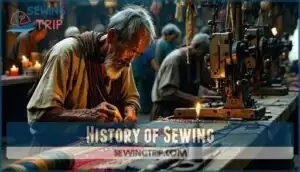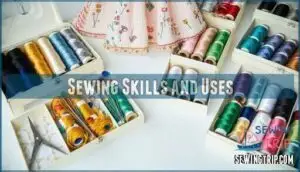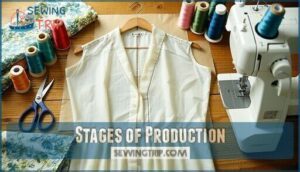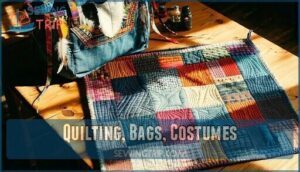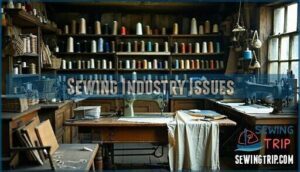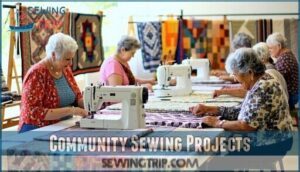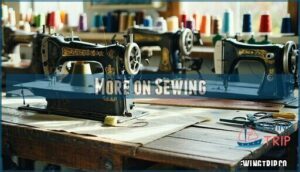This site is supported by our readers. We may earn a commission, at no cost to you, if you purchase through links.
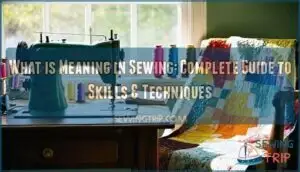
Sewing transforms simple fabric pieces into clothing, home décor, and crafts. You’ll use basic stitches to repair torn items or create complex garments from scratch.
This skill connects you to generations of makers who’ve shaped textiles into functional art. Whether you’re hemming pants or crafting quilts, sewing gives you control over your wardrobe and surroundings.
It’s both practical problem-solving and creative expression rolled into one satisfying hobby. The techniques you master open doors to endless project possibilities, allowing for complex garments to be created from scratch.
Table Of Contents
Key Takeaways
- You’ll master a practical skill that combines problem-solving with creative expression, allowing you to repair clothing, create custom garments, and transform simple fabric pieces into functional art that reflects your personal style.
- You’re connecting to 20,000 years of human history and cultural traditions, joining generations of makers who’ve shaped textiles into essential items while preserving skills that our ancestors used for survival and self-expression.
- You’ll gain control over your wardrobe and surroundings by learning techniques that save money on repairs, enable custom clothing creation, and open doors to endless project possibilities from basic hemming to complex garment construction.
- You’re developing both hand-eye coordination and patience through methodical processes that require precision, whether you’re using traditional hand-stitching methods or modern sewing machines to create lasting, quality pieces.
Definition of Sewing
You’ve probably sewn a button back on a shirt or fixed a torn seam at some point in your life.
Sewing connects generations through needle and thread, transforming simple fabric into treasured memories and practical solutions.
Sewing is the process of joining pieces of fabric together using a needle and thread, whether you’re doing it by hand or with a machine.
Examples
What exactly counts as sewing? You’ll find countless sewing examples across different skill levels and applications.
Basic repair examples include mending torn jeans or fixing loose buttons. Beginner projects encompass simple tote bags and pillow covers. Advanced projects involve complex garment construction with darts and zippers.
Here are common sewing applications:
- Clothing repair – fixing seams and hems
- Home décor – curtains and cushions
- Accessories – bags and scarves
- Quilting – decorative bed covers
- Costumes – theatrical or Halloween outfits
Market Categories
The sewing world splits into clear market categories that shape how you buy supplies and learn skills.
Sewing Retail stores offer everything from basic threads to specialty machines. Online Sales platforms connect you with global suppliers and Custom Sewing patterns. Niche Markets serve quilters, fashion designers, and crafters with targeted products.
| Market Category | What You’ll Find |
|---|---|
| Sewing Retail Stores | Fabric, notions, machines, pattern books |
| Online Sales Platforms | Global suppliers, bulk materials, reviews |
| Niche Markets | Specialty tools, quilting supplies, embroidery |
| Custom Sewing Services | Alterations, custom garments, repairs |
| Sewing Education Centers | Classes, workshops, certification programs |
Understanding these categories helps you navigate the sewing definition landscape more effectively. The sewing thread market is projected to reach $4.84 billion by 2034.
Each serves different skill levels and project types, from beginner sewing terms to advanced sewing vocabulary concepts.
History of Sewing
Looking at sewing’s rich past reveals how you’re part of an incredible journey. Ancient handwork began roughly 20,000 years ago when early humans used bone needles to stitch animal hides together.
This needlework formed the foundation of survival and self-expression.
The machine revolution in the 1800s changed everything. What once took hours by hand could now be completed in minutes.
This shift sparked major economic shifts as factories replaced home-based production.
Cultural traditions evolved alongside these changes:
- Medieval guilds controlled sewing techniques and quality standards
- Renaissance embroidery elevated needlework to artistic expression
- Industrial age brought mass production and ready-made clothing
- Modern era sees renewed interest in handmade crafts.
Today’s textile evolution connects you to generations of sewers who’ve shaped how we dress, decorate, and express creativity through fabric and thread.
Sewing Skills and Uses
You’ll find sewing skills open doors to many practical uses in your daily life.
These abilities let you create clothing, repair torn items, make crafts, and even start your own business.
Binding, Clothing, Crafts
From ancient hand-stitching roots, modern sewing transforms raw fabric into finished pieces through binding techniques and textile manipulation.
You’ll master clothing design by understanding seam finishes that create clean edges and professional results.
Binding techniques serve three main purposes in your sewing projects:
- Edge finishing – Clean raw fabric edges to prevent fraying
- Seam reinforcement – Strengthen high-stress areas in clothing construction
- Decorative elements – Add visual interest through contrasting bias tape
- Craft applications – Finish quilts, bags, and home décor items.
Many sewers explore advanced edge binding methods.
Gender Roles
Throughout sewing history, needlework traditionally belonged to women while men dominated workshops and trades.
This gendered skill created both limitations and opportunities for empowerment. Today’s shifting perceptions welcome all genders into sewing communities.
Gendered marketing still exists, but DIY clothing movements prove anyone can master these techniques. Modern sewing culture celebrates inclusion over old restrictions.
Crafting can also be a powerful tool for political protest.
Sewing Tools and Materials
You’ll need the right tools and materials to create quality sewing projects from start to finish.
Your sewing machine works with essential items like bobbins, presser feet, and feed dogs to move fabric smoothly.
You control the speed with the foot pedal.
Stages of Production
Production in sewing follows a clear roadmap from concept to completion. You’ll master each stage to create professional-quality garments that showcase your growing expertise.
The sewing production process breaks down into these essential phases:
- Design and Pattern Making – Create blueprints that guide your fabric cutting and garment construction decisions
- Cutting and Preparation – Transform fabric types into precise pieces using proven sewing techniques
- Assembly and Finishing – Unite components through careful stitching and professional edge treatments
Quality Control happens throughout each stage. You’ll check measurements, test seams, and refine details. This systematic approach transforms simple sewing projects into masterpieces. Essential tools like quality sewing needles are needed for each phase.
Tools Used
Essential sewing tools make the difference between frustration and success in your projects.
Your sewing machine needs regular machine maintenance to run smoothly and create perfect stitches.
Different needle types work best with specific fabrics – ballpoint needles for knits, sharp needles for woven materials.
Thread quality affects every seam you create, so invest in good brands.
Sharp cutting tools like fabric scissors and rotary cutters give clean edges.
Measuring tools including rulers, tape measures, and seam gauges guarantee accuracy.
These basic sewing tools form your creative foundation.
Regularly cleaning your machine can prevent costly repairs later.
Sewing Techniques and Projects
You’ll use different sewing techniques to create projects like clothing, quilts, bags, and costumes.
These techniques include basic stitches, construction methods, and finishing touches that help you build skills from simple repairs to complex garments.
Clothing Construction
When constructing clothing, you’ll transform fabric into wearable garments through careful pattern making and precise sewing techniques.
Master these essential steps:
- Pattern Making – Draft or adjust patterns to fit your measurements perfectly
- Fabric Selection – Choose materials that match your garment’s intended use and drape
- Seam Finishes – Apply proper techniques to prevent fraying and guarantee durability
Smart fitting issues prevention starts with accurate alterations techniques.
Proper fabric grain identification helps guarantee a seamless finished product.
Quilting, Bags, Costumes
Beyond basic clothing construction, you’ll discover quilting patterns that tell stories through fabric squares.
Each quilt block becomes a memory preserved in cotton and thread.
Bag design transforms scraps into functional art.
Costume materials breathe life into characters through creative sewing techniques.
These sewing crafts embrace textile upcycling, turning forgotten fabric into treasured pieces that reflect your personal style and imagination.
Many quilters source their assorted quilting materials to begin new projects, using their personal style and imagination to create unique pieces.
Sewing Industry Issues
You’ll notice the sewing industry faces big changes as companies move production to other countries for cheaper labor costs.
This shift affects traditional textile arts and causes many local sewing skills to disappear from communities, leading to a loss of local sewing skills.
Outsourcing
You’ll face tough choices when your sewing business grows.
Offshore sewing offers major cost savings but raises ethical concerns about worker conditions.
Many sewing manufacturers promise quality control, yet supply chains can break down.
Smart sewing entrepreneurship means balancing profits with principles.
Before partnering with any sewing factory, research their practices thoroughly, considering factors like worker conditions and supply chains to ensure alignment with your values.
Your brand’s reputation depends on choosing sewing producers who share your values.
Textile Art and Loss
Through textile art, you transform grief into powerful memory cloths that honor loved ones.
Through needle and thread, you weave stories that speak when words cannot, creating lasting tributes from the heart.
Symbolic stitching becomes art therapy, helping you process loss while creating meaningful textile memorials.
- Grief expression: Embroidery designs capture emotions words can’t express
- Memory preservation: Needlework skills create lasting tributes to those you’ve lost
- Healing process: Sewing inspiration flows from transforming pain into beautiful remembrance pieces
Community Sewing Projects
Community sewing projects bring people together through shared creativity and purpose.
You’ll find sewing groups in churches, community centers, and libraries where members work on meaningful collaborations.
These sewing communities create quilts for veterans through Quilts of Valor, blankets for sick children via Project Linus, and pillowcase dresses for Little Dresses for Africa.
When you join these sewing collaborations, you’re not just learning new techniques – you’re making a real social impact.
Skill sharing happens naturally as experienced sewers teach beginners proper hemming and appliqué methods.
Your mental wellbeing improves through regular social connections and the satisfaction of helping others.
Many groups focus on sustainable sewing by turning donated fabrics into useful items.
These efforts can include transforming old jeans into tote bags and quilts.
You’ll discover that this sewing hobby connects you with like-minded people while creating positive change in your community through project collaboration.
More on Sewing
You’ll find the word "sewing" has deep roots that stretch back thousands of years across many cultures.
Understanding where this term comes from helps you appreciate how this essential skill has shaped human history and continues to connect us today.
Dictionary and Sources
Looking up sewing definitions requires careful source reliability checks.
You’ll find etymology research reveals how sewing vocabulary evolved over centuries.
Cross-referencing multiple dictionaries helps understand semantic nuances between similar terms.
Definition evolution shows language changes in textile arts.
Build your sewing glossary using trusted references.
Good sewing language understanding starts with accurate definitions from reliable sources that explain technical terms clearly, which is essential for a strong foundation in sewing vocabulary.
Word History and Origin
Sewing’s etymology traces back to Middle English "sewen," revealing how our craft evolved through linguistic evolution.
Understanding root words helps you grasp deeper meanings in your sewing vocabulary.
- Ancient Origins: Germanic roots connect to "siujan," meaning to stitch
- Semantic Change: Terms shifted from basic joining to artistic expression
- Modern Glossary: Today’s sewing definitions blend traditional and technical language
- Living Language: Sewing terms continue evolving with new techniques
Frequently Asked Questions (FAQs)
What is the full meaning of sewing?
You’re working with the art of joining fabric pieces together using needle and thread.
It’s done by hand or machine to create clothing, repairs, and decorative items for practical and creative purposes.
What is the meaning of soeing?
Like a thread that’s lost its way, "soeing" appears to be a misspelling of "sewing".
You’re likely asking about sewing, which means joining fabric pieces together using needle and thread to create garments or repairs.
What is the other meaning of sewing?
Beyond joining fabric pieces, you’ll find sewing carries deeper meanings.
It represents self-sufficiency, creativity, and cultural heritage.
You’re connecting to traditions passed down through generations while expressing personal style and resourcefulness.
What does turn in mean in sewing?
Roughly 90% of sewers struggle with seam finishing techniques.
"Turn in" means you’re folding the raw edge of fabric inward, typically a quarter-inch, before stitching.
This creates clean, finished edges that won’t fray over time.
What are some tips for teaching kids how to sew?
Start with simple hand-sewing projects like straight stitches on fabric scraps.
Use colorful thread and large needles they can grip easily.
Keep sessions short, praise their efforts, and let them choose fun fabrics to maintain interest, focusing on simple hand-sewing and fun fabrics.
Where can I find sewing patterns and supplies locally?
A stitch in time saves nine!
Check local fabric stores, craft chains like Jo-Ann’s, and quilting shops for patterns and supplies.
You’ll also find treasures at thrift stores, estate sales, and online marketplaces for budget-friendly options.
How do I choose the right sewing machine for my needs?
Consider your projects, budget, and skill level first. Beginners need basic straight-stitch machines. Advanced sewers want computerized features. Test machines in-store, check warranty coverage, and read reviews before buying.
What sewing blogs or YouTube channels do you recommend for beginners?
Nearly 75% of sewers learn from online tutorials today.
You’ll love Evelyn Wood’s beginner-friendly YouTube channel and WithWendy’s step-by-step guides.
The Sewing Rabbit blog offers clear instructions that’ll boost your confidence quickly.
What are common mistakes people make when learning to sew?
You’ll often skip reading patterns thoroughly, choose wrong fabric types, forget to pre-wash materials, rush through cutting, and ignore seam allowances.
These shortcuts create wonky fits and frustrating do-overs that’ll test your patience.
What thread weight works best for beginners?
All-purpose thread in weight 40 or 50 gives you versatility, strength, and forgiveness.
You’ll handle cotton, polyester, and blends easily.
Start with these weights—they’re forgiving when tension’s off and work for most beginner projects perfectly.
Conclusion
Over 95% of people who learn to sew continue the hobby for life, showing its lasting appeal.
Understanding what’s meaning in sewing reveals it’s more than just joining fabric pieces together. You’ve discovered it’s a practical skill that saves money, repairs items, and creates custom clothing.
Sewing connects you to history while building problem-solving abilities. Whether you’re fixing a tear or crafting complex garments, you’re mastering a timeless art that blends creativity with function.
- https://www.collinsdictionary.com/us/dictionary/english/sewing
- http://www.savilerowbespoke.com/about-us/tailoring-terms/
- https://en.wikipedia.org/wiki/Sewing
- https://docs.google.com/forms/d/1GAQr3Kn1cURCVHUA82hAga1Wv8DCH0IuqDLRUrOpN7M/viewform?ts=63f4f653&entry.1515682415=https://www.merriam-webster.com/dictionary%2Fsewing
- https://premium.britannica.com/mw-unabridged/?utm_source=mw&utm_medium=inline-def&utm_campaign=evergreen

